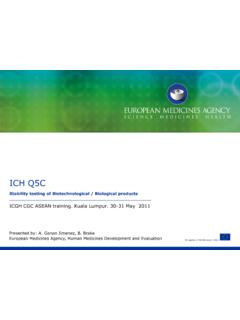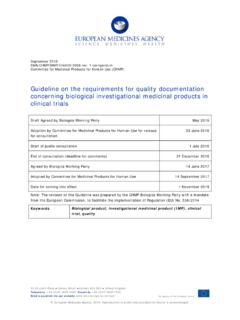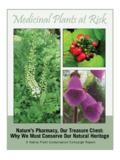Transcription of PRINCIPLES OF MEDICINAL CHEMISTRY
1 1 PRINCIPLES OF MEDICINAL CHEMISTRY In this book we consider the following fundamental areas of MEDICINAL CHEMISTRY Basic concepts, in which the fundamentals of MEDICINAL CHEMISTRY are exposed Development or genesis of drugs, in which the methods for obtaining and designing new drugs are given Theoretical aspects of drug action, where mainly the following items are studied: relationship between chemical structure and biological activity, theories of drug action, and mechanism of drug action Major methods used in the analysis of pharmaceuticals INTRODUCTION Definition MEDICINAL CHEMISTRY , also called therapeutic CHEMISTRY , pharmaceutical CHEMISTRY , pharmacochemistry.
2 And chemical pharmacy is that field of pharmaceutical sciences which applies the PRINCIPLES of CHEMISTRY and biology to the creation of knowledge leading to the introduction of new therapeutic agents. So, the primary objective of MEDICINAL CHEMISTRY is the design and discovery of new compounds that are suitable for use as drugs. The discovery of a new drug requires not only design and synthesis but also the development of testing methods and procedures, which are needed to establish how a substance operates in the body and its suitability for use as a drug.
3 Drug discovery may also require fundamental research into the biological and chemical nature of the diseased state. Thus the MEDICINAL chemist must not only be a competent organic chemist but must have a basic background in biological sciences, particularly biochemistry and pharmacology. MEDICINAL CHEMISTRY also studies the physical and chemical properties of drug, the methods of drug quality control. The relationship of MEDICINAL CHEMISTRY to other disciplines is indicated in the following diagram: CHEMISTRY and Biochemistry Pharmaceutics and Biopharmaceutics MEDICINAL CHEMISTRY Pharmacology Internal Medicine Biology and Microbiology Toxicology and Pathology 2 Historical evolution Since ancient times the people of the world have used a wide range of natural products for MEDICINAL purposes.
4 These products, obtained from animal, vegetable and mineral sources, were sometimes very effective. The Chinese, Hindus, and people from Mediterranean were familiar with the therapeutic use of certain plants and some minerals. In his writings on MEDICINAL herbs, the Chinese emperor Shen Nung (about 3000 ) recommended the use of the plant Ch ang shang for the treatment of malaria; it is known that this plant contains alkaloids, such as febrifugine, which are endowed with antimalarial activity.
5 The Brazilian Indians used to treat dysentery and diarrhea with Ipecacuanha root; in fact, it contains emetine, which is effective against these ills. Hippocrates, in the late fifth century , recommended the application of metallic salts; his teachings, despite many errors, were to influence occidental medical treatment for nearly 2000 years. However, many of the products were very toxic. In the Middle Ages, Paraselsus (1493-1541), adopted antimony and its derivatives as a panacea, thereby becoming the father of iatrochemistry (iatro's means physician ).
6 He also called attention to the fact that remedies could be useful as well as harmful. Information about these ancient remedies was not readily available to users until the invention of the printing press in the 15th century. This invention led to the widespread publication and circulation of herbals and pharmacopoeias. The first pharmacopeias were published in the sixteenth century. In the following century, the therapeutic arsenal was enriched with new drugs of vegetal and mineral origin. With the progress in CHEMISTRY , isolated products of higher purity came to be preferred to crude extracts.
7 Digitalis, ether, opium, and other drugs were introduced in the nineteenth century. MEDICINAL CHEMISTRY received a large impulse from the discovery made forward the end of the nineteenth century by Paul Ehrlich (1854-1915), father of modern chemotherapy. He produced the antiprotozoal arsphemamine (Salvarsan) in 1910 by combining synthesis with reliable biological screening and evaluation procedures. Ehrlich had recognized that beneficial and toxic properties of a drug were important to its evaluation.
8 He realized that the more effective drugs showed a greater selectivity for the target microorganism than its host. Consequently, to compare the effectiveness of different compounds, he expressed a drug s selectivity, and hence its effectiveness, in term of its chemotherapeutic index, which he defined as Chemotherapeutic index = minimum curative dose maximum tolerated dose Today, Ehrlich s chemotherapeutic index has been updated to take into account the variability of individuals and is now defined as its reciprocal, the therapeutic index or ratio.
9 3 Therapeutic index = Lethal dose required to kill 50% of the test animals (LD50) The dose producing an effective therapeutic response in 50% of the test sample (ED50) In theory, the larger a drug s therapeutic index, the greater is its margin of safety. However, in practice index values can only be used as a limited guide to the relative usefulness of different compounds. The term structure-activity relationship (SAR) is now used to describe Ehrlich s approach to drug discovery, which consisted of synthesizing and testing a series of structurally related compounds.
10 Attempts to quantitatively relate chemical structure to biological action were first indicated in the 19th century, but it was not until the 1960s that Hansch and Fujita devised a method that successfully incorporated quantitative measurements into SAR determination. This technique is referred to as QSAR (quantitative structure-activity relationships). One of its most successful uses has been in the development in the 1970s of the antiulcer agents cimetidine and ranitidine. Both SARs and QSARs are important parts of the foundations of MEDICINAL CHEMISTRY .





